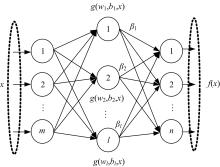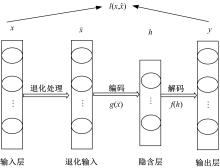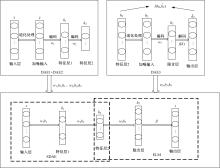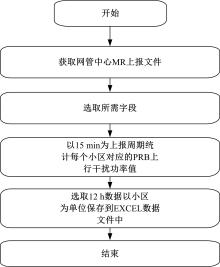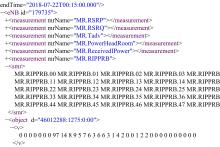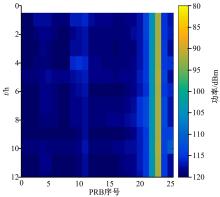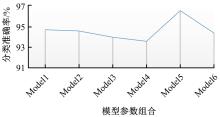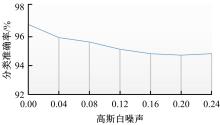吉林大学学报(工学版) ›› 2022, Vol. 52 ›› Issue (1): 195-203.doi: 10.13229/j.cnki.jdxbgxb20200876
• 计算机科学与技术 • 上一篇
结合降噪自编码与极限学习机的LTE上行干扰分析
- 1.山东建筑大学 信息与电气工程学院,济南 250101
2.山东建筑大学 山东省智能建筑技术重点实验室,济南 250101
3.中国政法大学 青少年犯罪与少年司法研究中心,北京 100088
4.湖南亿恩科技有限公司 AI研究院,山东 青岛 266000
LTE uplink interference analysis combined with denoising autoencoder and extreme learning machine
Hong-kui XU1,2( ),Tong-tong JIANG1,Xin LI1,Bin-xiang JIANG1,3,Yong-lei WANG4
),Tong-tong JIANG1,Xin LI1,Bin-xiang JIANG1,3,Yong-lei WANG4
- 1.School of Information and Electrical Engineering,Shandong Jianzhu University,Jinan 250101,China
2.Shandong Key Laboratory of Intelligent Building Technology,Shandong Jianzhu University,Jinan 250101,China
3.Juvenile Crime & Justice Research Center,China University of Political Science & Law,Beijing 100088,china
4.AI Research Institute,Hunan ENHT Technology Co. ,Ltd. ,Qingdao 266000,China
摘要:
针对长期演进LTE网络上行干扰分类模型中噪声敏感、训练时间长的问题,建立了结合堆栈降噪自编码器与极限学习机的LTE网络上行干扰分析模型。使用上行干扰原始数据无监督地预训练堆栈降噪自编码(SDAE)提取高层抽象特征,并为极限学习机(ELM)分类器提供初始参数。该模型发挥了ELM收敛快和SDAE抑制噪声的优势,同时克服了ELM参数随机赋值造成的鲁棒性不足的问题。实验结果表明,该模型提高了LTE网络上行干扰分析的效率,并具有较强的鲁棒性。
中图分类号:
- TP391
| 1 | 王建,刘方森,赵昌盛. 基于MR数据TD-LTE上行干扰分析方法研究[J].电信技术,2017(1):63-65. |
| Wang Jian, Liu Fang-sen, Zhao Chang-sheng. Research on TD-LTE uplink interference analysis method based on MR data[J]. TelecommunicationsTechnology,2017(1):63-65. | |
| 2 | 翁文迪.TD-LTE系统间干扰检测与分类的研究及实现[D]. 北京:北京交通大学电气学院,2015. |
| Weng Wen-di. Study and implementation of detection and classification for the inter system Interference to TD-LTE[D]. Beijing: School of Electrical Engineering,Beijing Jiaotong University, 2015. | |
| 3 | 刘思.基于TD-LTE上行干扰数据的多维度干扰类型识别算法研究与验证[D].北京: 北京邮电大学信息与通信工程学院,2017. |
| Liu Si. Research and verification of multiple dimensions interference recognition algorithm based on TD-LTE upstream interference data[D].Beijing: School of Information and Communication Engineering, Beijing University of Posts and Telecommunications, 2017 | |
| 4 | 李颖. LTE网络上行干扰分析技术及应用[D].北京:北京邮电大学信息与通信工程学院,2017 |
| Li Ying. Analysis and application of LTE network uplink interference[D]. Beijing: School of Information and Communication Engineering,Beijing University of Posts and Telecommunications, 2017 | |
| 5 | 孙黎明. TD-LTE系统上行干扰排查方法研究[D].大连:大连理工大学信息与通信工程学院,2019. |
| Sun Li-ming, Research on uplink interference identification and avoiding methods of TD-LTE system[D]. Dalian: School of Information and Communication Engineering,Dalian University of Technology, 2019. | |
| 6 | Huang Guang-bin,Zhu Qin-Yu,Siew Chee- kheong. Extreme learning machine theory and applications[J]. Neurocomputing,2006,70(1-3) :489-501. |
| 7 | Huang Zhi-yong, Yu Yuan-long, Gu Jason, et al. An efficient method for traffic sign recognition based on extreme learning machine[J]. IEEE Transactions on Cybernetics, 2016, 47(4):920-933. |
| 8 | Iosifidis A, Tefas A. Approximate kernel extreme learning machine for large scale data classification[J].Neurocomputing,2017,219(5):210-220. |
| 9 | Chen Zhi-cong, Wu Li-jun, Cheng Shu-ying, et al. Intelligent fault diagnosis of photovoltaic arrays based on optimized kernel extreme learning machine and I-V characteristics[J]. Applied Energy, 2017,204(15):912-931. |
| 10 | Gang Yin, Zhang Ying-tang, Li Zhi-ning, et al. Online fault diagnosis method based on incremental support vector data description and extreme learning machine with incremental output structure[J]. Neurocomputing, 2014, 128(27):224-231. |
| 11 | Lan Yuan, Hu Zong-jiang, Soh Yeng Chai, et al. An extreme learning machine approach for speaker recognition[J]. Neural Computing & Applications, 2013, 22(3/4):417-425. |
| 12 | Yan Xu, Dai Yuan-yu, Zhao Yang-dong, et al. Extreme learning machine-based predictor for real-time frequency stability assessment of electric power systems[J]. Neural Computing & Applications, 2013,22(18):501-508. |
| 13 | Duan Ming-xing, Li Ken-li, Li Keqin. An ensemble CNN2ELM for age estimation[J]. IEEE Transactions on Information Forensics and Security,2018,13 (3) : 758-772. |
| 14 | 王晓丹, 来杰,李睿,等.多层去噪极限学习机[J].吉林大学学报:工学版,2020,50(3):1031-1039. |
| Wang Xiao-dan, Lai Jie, Li Rui, et al. Multi-layer denoising extreme learning machine[J]. Journal of Jilin University(Engineering and Technology Edition), 2020,50(3):1031-1039. | |
| 15 | 张卫东,路皓翔,甘博瑞,等.基于栈式自编码融合极限学习机的药品鉴别[J]. 计算机工程与设计,2019,40(2):545-549, 561. |
| Zhang Wei-dong, Lu Hao-xiang, Gan Bo-rui, et al. Drug identification based on stacked auto encoders fusing extreme learning machine[J]. Computer Engineering and Design,2019,40(2):545-549, 561. | |
| 16 | Huang Guang-bin, Liang Nan-ying, Rong Hai-jun, et al. On-Line sequential extreme learning machine[C]∥The Fourth IASTED International Conference on Computational Intelligence, Calgary, Canada, 2005:62-67. |
| 17 | Huang Guang-bin, Song Shi-ji,Huang Gao,et al. Trends in extreme learning machines: a review[J]. Neural Networks, 2015, 61:32-48. |
| 18 | Vincent P, Larochelle H, Bengio Y, et al. Extracting and composing robust features with denoising autoencoders[C]∥Proceedings of the 25th International Conference on Machine Learning, Helsinki, Finland, 2008: 1096-1103. |
| [1] | 刘桂霞,裴志尧,宋佳智. 基于深度学习的蛋白质⁃ATP结合位点预测[J]. 吉林大学学报(工学版), 2022, 52(1): 187-194. |
| [2] | 刘远红,郭攀攀,张彦生,李鑫. 基于黎曼流形的稀疏图保持投影的特征提取[J]. 吉林大学学报(工学版), 2021, 51(6): 2268-2279. |
| [3] | 钟辉,康恒,吕颖达,李振建,李红,欧阳若川. 基于注意力卷积神经网络的图像篡改定位算法[J]. 吉林大学学报(工学版), 2021, 51(5): 1838-1844. |
| [4] | 朱小龙,谢忠. 基于海量文本数据的知识图谱自动构建算法[J]. 吉林大学学报(工学版), 2021, 51(4): 1358-1363. |
| [5] | 徐涛,马克,刘才华. 基于深度学习的行人多目标跟踪方法[J]. 吉林大学学报(工学版), 2021, 51(1): 27-38. |
| [6] | 周炳海,何朝旭. 基于线边集成超市的混流装配线动态物料配送调度[J]. 吉林大学学报(工学版), 2020, 50(5): 1809-1817. |
| [7] | 黄辉, 冯西安, 魏燕, 许驰, 陈慧灵. 基于增强核极限学习机的专业选择智能系统[J]. 吉林大学学报(工学版), 2018, 48(4): 1224-1230. |
| [8] | 耿庆田, 于繁华, 王宇婷, 高琦坤. 基于特征融合的车型检测新算法[J]. 吉林大学学报(工学版), 2018, 48(3): 929-935. |
| [9] | 董强, 刘晶红, 周前飞. 用于遥感图像拼接的改进SURF算法[J]. 吉林大学学报(工学版), 2017, 47(5): 1644-1652. |
| [10] | 尹明, 战荫伟, 裴海龙. 基于稀疏补算子学习的图像融合方法[J]. 吉林大学学报(工学版), 2016, 46(6): 2052-2058. |
| [11] | 肖钟捷. 基于小波空间特征谱熵的数字图像识别[J]. 吉林大学学报(工学版), 2015, 45(6): 1994-1998. |
| [12] | 刘红,孙爽滋,王庆元,李延忠. 基于PSO的模拟电路故障信息特征提取[J]. 吉林大学学报(工学版), 2015, 45(2): 675-680. |
| [13] | 潘海阳, 刘顺安, 姚永明. 基于深度信息的自主空中加油技术[J]. 吉林大学学报(工学版), 2014, 44(6): 1750-1756. |
| [14] | 李学军, 杨晟, 李振举, 杨阿华, 刘涛. 与高精度单点匹配式定位算法[J]. 吉林大学学报(工学版), 2014, 44(4): 1197-1202. |
| [15] | 顾播宇,孙俊喜,李洪祚,刘红喜,刘广文. 基于特征加权模块双方向二维主成分分析的人脸识别[J]. 吉林大学学报(工学版), 2014, 44(3): 828-833. |
|
||
